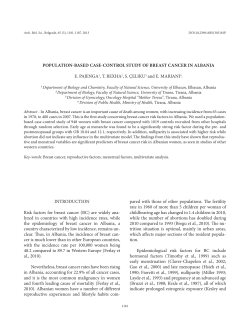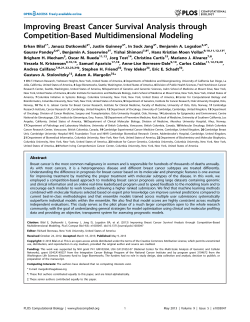
Introduction
ISSN: 2347-3215 Volume 1 Number 1 (2013) pp. 106-111 www.ijcrar.com Cytotoxic properties of Acorus calamus in MCF -7 breast cancer cells S.B. Sreejaya and K.S. Santhy* Department of Zoology, Avinashilingam Institute for Home Science and Higher Education for Women, Coimbatore -641 043, Tamil Nadu, India *Corresponding author e-mail: santhyanandan@gmail.com KEYWORDS A B S T R A C T Acorus calamus; Cytotoxicity; IC50; MTT assay. In this study cytotoxic effect of Acorus calamus extract was evaluated on breast carcinoma (MCF-7) cell lines. MCF-7 cells were cultured in DMEM medium and incubated with different concentrations (18.75, 37.5, 75, 150 and 300 g/ml) of Acorus calamus methanol extract. Cell viability was assessed by MTT assay. Acorus calamus decreased cell viability in malignant cells in a concentration dependent manner. The IC50 values in MCF-7 cells were determined as 52.07 g/ml. It may be concluded that Acorus calamus can cause cell death in MCF-7 cancer cells which can be considered as a promising chemotherapeutic agent in breast cancer treatment. . Introduction Cancer has been thought to be a preventable disease due to its slow development and progression, taking many years to become invasive in a step by- step manner (Yao et al., 2011). Such property provides a great opportunity not only for early detection, but also for prevention of the disease progression. Despite this, breast cancer is the most frequently diagnosed cancer in women worldwide and ranks second as a cause of cancer death (Am.Can.Soc: Cancer Facts and Figures 2012). Over the past several decades, there has been a particular interest in the role of medicinal plant extracts in cancer prevention. Plants are rich sources of chemically diverse compounds, many with beneficial properties to human health. Consequently, about 50% of the anticancer therapeutic agents known are derived from plants (Balunas and Kinghorn, 2005). For example, compounds such as Taxol and vinca alkaloids act to destabilize the microtubules of cancer cells, preventing the rapid proliferation of tumors (Prasain and Barnus, 2007). Acorus calamus (known as calamus or sweet flag) (A. calamus) is a perennial plant with flavoring scent that grows in aquatic 106 environments. It has a long history of medical, cultural, and ritual use and hence was spread outside its indigenous areas in Asia and is now found across Australia, Europe, and North America (Ratsch.,2005). In India, traditional use of A. calamus in ayurvedic medicine is documented for treatment of insomnia, neurosis, and remittent fevers. Extractives of different parts of Acorus calamus and calamus oil are widely used now in pharmaceuticals, traditional systems of medicines for a number of ailments and in perfumes. Here it has generated a lot of interest amongst the scientist to evaluate the activity by using modern parameters too. The solvent was removed by evaporation and extract was concentrated by using vacuum rotator evaporator. Chemicals 3-(4, 5-dimethyl thiazol-2-yl)-5-diphenyl tetrazolium bromide (MTT), Fetal Bovine Serum (FBS), Phosphate Buffered Saline (PBS), Eagle s minimum essential medium (DMEM) and Trypsin were obtained from sigma Aldrich Co, St. Louis, USA. EDTA, glucose, Trichloroacetic acid (TCA), Acetic acid, Tris base and antibiotics from Himedia Laboratories Ltd., Mumbai. Dimethyl Sulfoxide (DMSO) and Propanol from E. Merck Ltd., Mumbai, India. Cytotoxicity has been defined as the cell killing property of a chemical compound independent from the mechanism of death (Graham-Evans et al., 2003). Cytotoxicity assay is an appropriate method for screening new substances within a short time in order to determine cytotoxicity on cancer cells (Alley et al., 1988). Usually in oncology research and clinical practices, in vitro testing is preferred prior to in vivo testing. In vitro cultures can be cultivated under a controlled environment (pH, temperature, humidity, oxygen / CO2 balance etc.) resulting in a homogenous batches of cells and thus minimizing experimental errors. MTT assay has been described as rapid, simple and reproducible method, widely used in the screening of anticancer drugs and to measure the cytotoxic properties. Hence in the current study, the cytotoxic properties of A.calamus was evaluated using this assay. Cell Lines and Culture Medium The human Breast cancer cell line (MCF-7) was obtained from National Centre for Cell Sciences (NCCS), Pune and grown in Eagles minimum essential medium (EMEM) containing 10% Fetal Bovine Serum (FBS). All cells were maintained at 37 C, 5% CO2, 95% air and 100% relative humidity. Maintenance cultures were passage weekly, and the culture medium was changed twice a week. Cell Treatment Procedure The monolayer cells were detached with trypsin ethylenediamine tetra acetic acid (EDTA) to make single cell suspensions and viable cells were counted using a hemocytometer and diluted with medium containing 5% FBS to give final density of 1 x 105 cells / ml. One hundred micro litres per well of cell suspension were seeded in to 96-well plates at plating density of 10,000 cells / well and incubated to allow for cell attachment at 37 C, 5% CO2, 95% air and 100% relative humidity. After 24 h Materials and Methods A. calamus extract Dried and powered plant was extracted with methanol by using soxhlet apparatus. 107 Table.1 In vitro Cytotoxicity of Acorus calamus on MCF-7 cell lines Plant Extract Concentration ( g / ml) 18.75 37.5 Acorus calamus 75 150 300 % inhibition IC50 g / ml R2 17.04 45.23 52.07 0.97 58.64 77.86 94.50 Fig.1 Percentage growth inhibition of Acorus calamus against MCF-7 cell line % Growth Inhibition 100 80 60 40 20 0 0 1 2 3 Log10 concentration (µg/ml) the cells were treated with serial concentration of the test samples. They were initially dissolved in Dimethyl sulfoxide (DMSO) and diluted to twice the desired final maximum test concentration with serum free medium. Additional four, 2 fold serial dilutions were made to provide a total of five sample concentration. Aliquots of 100 l of these different sample dilutions were added to the appropriate wells already containing 100 l of medium, resulted the required final sample concentrations. MTT Assay After 48 h of incubation, 15 l of MTT (5 g / ml) in phosphate buffered saline (PBS) was added to each well and incubated at 37 C for 4 h. The medium with MTT was then flicked off and the formed formazan crystals were solubilized in 100 l of DMSO and then measured the absorbance at 570 nm using microplate reader. The % cell inhibition was determined using the following formula: Percentage cell inhibition = 100 Abs (Sample) / Abs (Control) x 100 Following treatment with methanolic extract of Acorus calamus, the plates were incubated for an additional 48 h at 37 C, 5% CO2, 95% air and 100% relative humidity. The medium without samples were served as control and triplicate was maintained for all concentrations. Statistical analysis Non linear regression graph was plotted between % cell inhibition and log10 concentration and IC50 was determined using graph pad prism software. 108 Fig.2 Proliferation of MCF-7 cells treated with Acorus calamus a b c d e a f Control ; b 18.75 g ; c 37.5 g;d 75 109 g;e 150 g ; f 300 g; compared with control. On the other hand the percentage of non-viable cells on cell lines increased with the increasing period of treatment. These results were in concordance with the studies investigated the cytotoxic effect of Goniothalamin towards human breast cancer cells by AlQubaisi et al., (2011). Result and Discussion The results for cell growth inhibition by the methanol extract of A.calamus on MCF-7 cell lines for various concentrations is shown in Table I. In the present study MCF cells showed growth inhibition in a dose dependent manner when treated with A.calamus at concentrations ranging from 18.75 g 300 g (Figs.1 & 2). The percentage of dead cells for each concentration was found to be 17.04, 45.23, 58.64, 77.86 and 94.50. The 50% cytotoxic effect (IC50) of A.calamus was found to be 52.07 g / ml. Several mechanisms of action were detected in MCF-7 cells. In the present study, methanol extract of A.calamus was found to be cytotoxic towards human MCF7 in MTT assay and the concentration required for 50% cell death was found to be 52.07 g / ml. Hence present study shows the efficacy of A.calamus for the cytotoxicity towards MCF-7 cells thus suggesting protection against breast cancer. In the last few decades, human cancer cell lines have aggregated an accessible, easily usable set of biological models to examine cancer biology (Green, 2003). The utility of cell lines acquired from tumor allows the investigation of tumor cells in a simplified and controlled environment (Arya et al., 2011). MTT cytotoxicity assay used to measure the cytotoxic effect of A.calamus on breast carcinoma (MCF-7) cells. In screening result, A.calamus has shown broad spectrum cytotoxicity and it had most active cytotoxic activity on breast carcinoma (MCF-7) cells. References Alley, M. C., D.A. Scudiro, A. Monks, M.L. Hursey. M.J. Czerwinski and Fine, D. L. 1988. Feasibility of drug screening with panels of human tumor cell lines using a microculture tetrazolium assay. Cancer Res. 48, 589601. Al-Qubaisi, M., R. Rozita, S.K. Yeap, et al. 2011. Selective cytotoxicity of Goniothalamin against Hepatoblastoma HepG2 Cells. Molecules, 16, 2944-59 American Cancer Society: Cancer Facts & Figures. 2012. In Atlanta, GA: American Cancer Society; 2012. Arya, V., C.P. Kashyap, T. Bandana, S. Shiksha, K. Sweta, P. Verma and Swati Sharma, 2011. Human cancer cell lines A brief communication, J. Chem. Pharm. Res. 3(6) : 514-520. Balunas, M.J., and Kinghorn, A.D. 2005. Drug discovery from medicinal plants. Life Sci. 78(5):431-441. Ferrari, M., M.C. Fornasiero and Isetta, A.M. 1990. MTT colorimetric assay for MTT proliferation assay was carried out to determine the growth rate of cells. In this study, methanol extract of A.calamus have indicated significant growth inhibition in MCF-7 cell line at low concentration of IC50 values. The IC50 of extract on cell line less than 100 g / ml is categorized as a potential cytotoxic substance (Spavieri et al., 2010). A linear relationship between the formazan generated and the number of viable cells was demonstrated, together with time-dependent growth characteristics for MCF-7 cells by Ferrari et al., (1990). A.calamus treatment on MCF-7 cell lines showed significant decrease in growth rate 110 testing macrophage cytotoxic activity in vitro. J. Immunological Methods. 131: 165-70. Graham-Evans, B., P.B. Tchounwou and Cohly, H.H. 2003. Cytotoxicity and proliferation studies with arsenic in established human cell lines: keratinocytes, melanocytes, dendritic cells, dermal fibroblasts, microvascular endothelial cells, monocytes and Tcells. Int. J. Mol. Sci. 4: 13-21. Green, J.E., 2003.Mouse models of human breast cancer: evolution or convolution. Breast Cancer Res. 5(1):1. Prasain, J.K., and Barnes, S. 2007. Metabolism and bioavailability of flavonoids in chemoprevention: current analytical strategies and future prospectus. Mol. Pharm. 4(6):846-864 Rätsch, C., 2005. The Encyclopedia of Psychoactive Plants. Park Street Press, Rochester, VT. Spavieri, J., A. Allmendinger, M. Kaiser, R. Casey, S. Hingley-Wilson and Lalvani, A. 2010. Antimycobacterial, antiprotozoan and cytotoxic potential of twenty-one brown algae (Phaeophyceae) from British and Irish waters. Phytother. Res. 24 : 1724-29. Yao, H., W. Xu, X. Shi, and Zhang, Z. 2011. Dietary flavonoids as cancer prevention agents. J .Environ. Sci. Health. 29(1):1-31. 111
© Copyright 2025





















